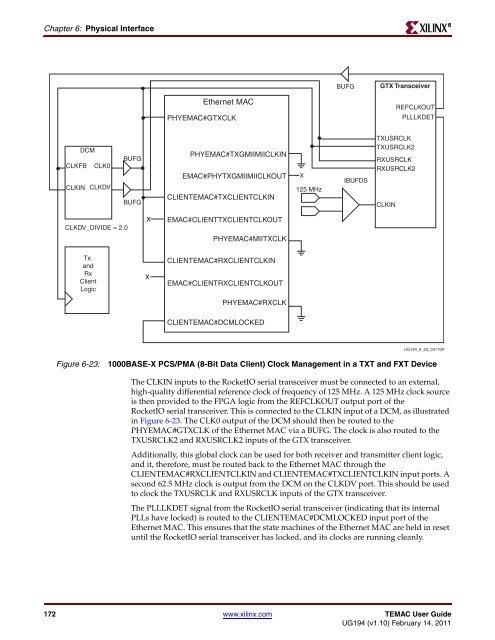Xilinx UG194 Virtex-5 FPGA Embedded Tri-Mode Ethernet MAC ...
Xilinx UG194 Virtex-5 FPGA Embedded Tri-Mode Ethernet MAC ...
Xilinx UG194 Virtex-5 FPGA Embedded Tri-Mode Ethernet MAC ...
You also want an ePaper? Increase the reach of your titles
YUMPU automatically turns print PDFs into web optimized ePapers that Google loves.
Chapter 6: Physical Interface<br />
CLKFB<br />
CLKIN<br />
DCM<br />
Tx<br />
and<br />
Rx<br />
Client<br />
Logic<br />
CLK0<br />
CLKDV<br />
CLKDV_DIVIDE = 2.0<br />
BUFG<br />
BUFG<br />
X<br />
X<br />
<strong>Ethernet</strong> <strong>MAC</strong><br />
PHYE<strong>MAC</strong>#GTXCLK<br />
PHYE<strong>MAC</strong>#TXGMIIMIICLKIN<br />
E<strong>MAC</strong>#PHYTXGMIIMIICLKOUT<br />
CLIENTE<strong>MAC</strong>#TXCLIENTCLKIN<br />
E<strong>MAC</strong>#CLIENTTXCLIENTCLKOUT<br />
PHYE<strong>MAC</strong>#MIITXCLK<br />
CLIENTE<strong>MAC</strong>#RXCLIENTCLKIN<br />
E<strong>MAC</strong>#CLIENTRXCLIENTCLKOUT<br />
PHYE<strong>MAC</strong>#RXCLK<br />
CLIENTE<strong>MAC</strong>#DCMLOCKED<br />
125 MHz<br />
IBUFDS<br />
GTX Transceiver<br />
TXUSRCLK<br />
TXUSRCLK2<br />
RXUSRCLK<br />
RXUSRCLK2<br />
<strong>UG194</strong>_6_23_031109<br />
Figure 6-23: 1000BASE-X PCS/PMA (8-Bit Data Client) Clock Management in a TXT and FXT Device<br />
The CLKIN inputs to the RocketIO serial transceiver must be connected to an external,<br />
high-quality differential reference clock of frequency of 125 MHz. A 125 MHz clock source<br />
is then provided to the <strong>FPGA</strong> logic from the REFCLKOUT output port of the<br />
RocketIO serial transceiver. This is connected to the CLKIN input of a DCM, as illustrated<br />
in Figure 6-23. The CLK0 output of the DCM should then be routed to the<br />
PHYE<strong>MAC</strong>#GTXCLK of the <strong>Ethernet</strong> <strong>MAC</strong> via a BUFG. The clock is also routed to the<br />
TXUSRCLK2 and RXUSRCLK2 inputs of the GTX transceiver.<br />
Additionally, this global clock can be used for both receiver and transmitter client logic,<br />
and it, therefore, must be routed back to the <strong>Ethernet</strong> <strong>MAC</strong> through the<br />
CLIENTE<strong>MAC</strong>#RXCLIENTCLKIN and CLIENTE<strong>MAC</strong>#TXCLIENTCLKIN input ports. A<br />
second 62.5 MHz clock is output from the DCM on the CLKDV port. This should be used<br />
to clock the TXUSRCLK and RXUSRCLK inputs of the GTX transceiver.<br />
The PLLLKDET signal from the RocketIO serial transceiver (indicating that its internal<br />
PLLs have locked) is routed to the CLIENTE<strong>MAC</strong>#DCMLOCKED input port of the<br />
<strong>Ethernet</strong> <strong>MAC</strong>. This ensures that the state machines of the <strong>Ethernet</strong> <strong>MAC</strong> are held in reset<br />
until the RocketIO serial transceiver has locked, and its clocks are running cleanly.<br />
172 www.xilinx.com TE<strong>MAC</strong> User Guide<br />
<strong>UG194</strong> (v1.10) February 14, 2011<br />
X<br />
BUFG<br />
CLKIN<br />
REFCLKOUT<br />
PLLLKDET<br />
R

















